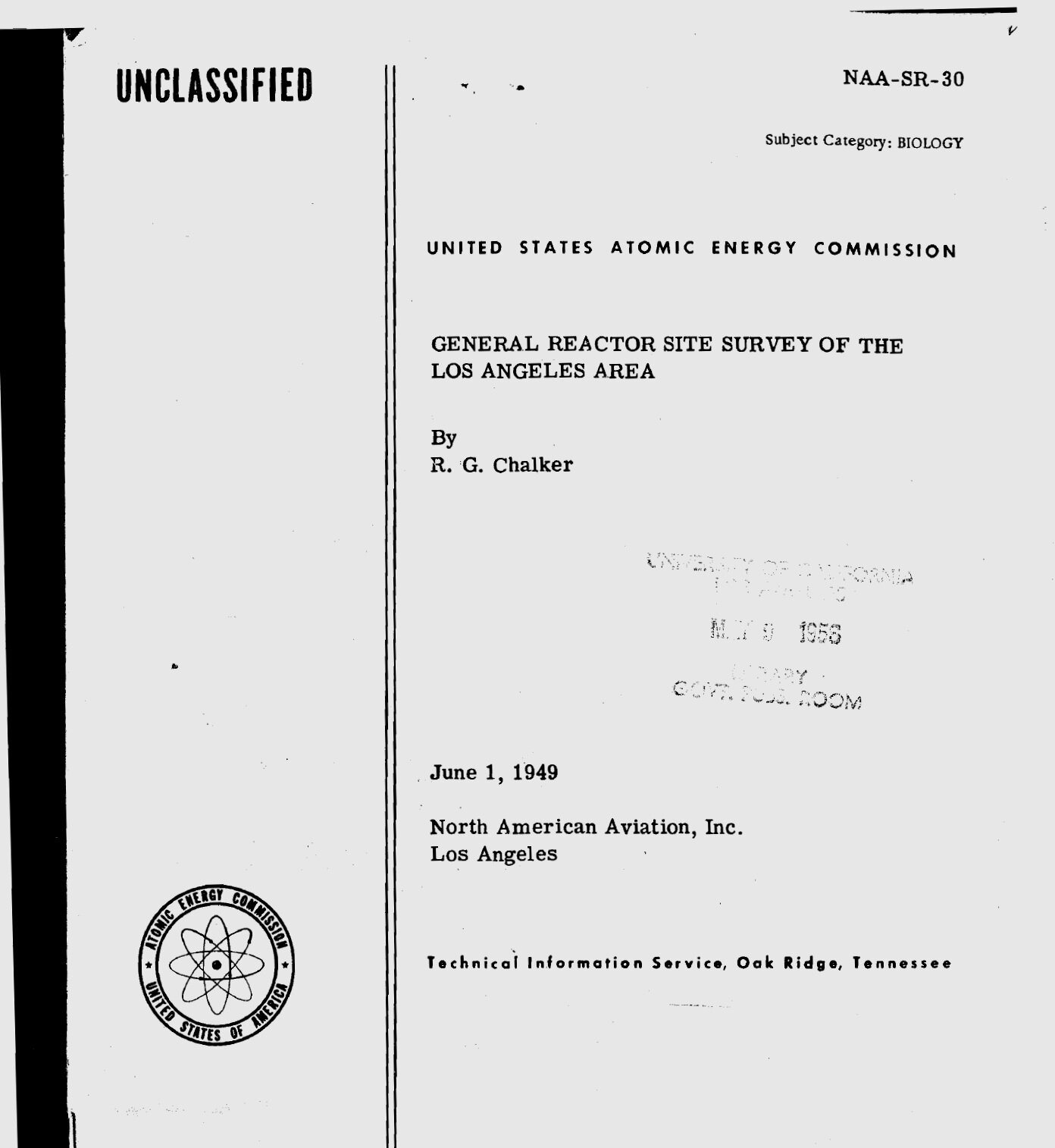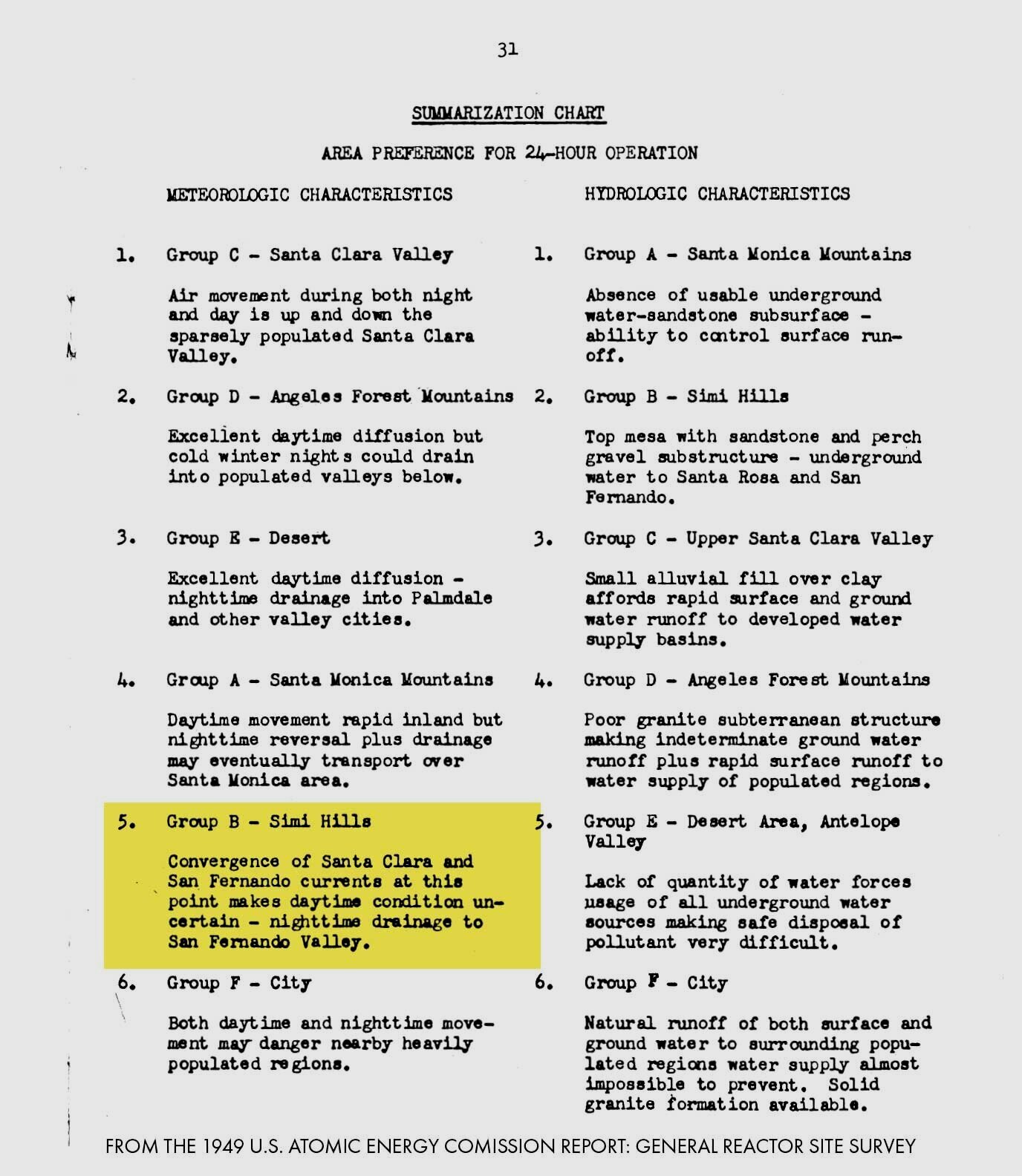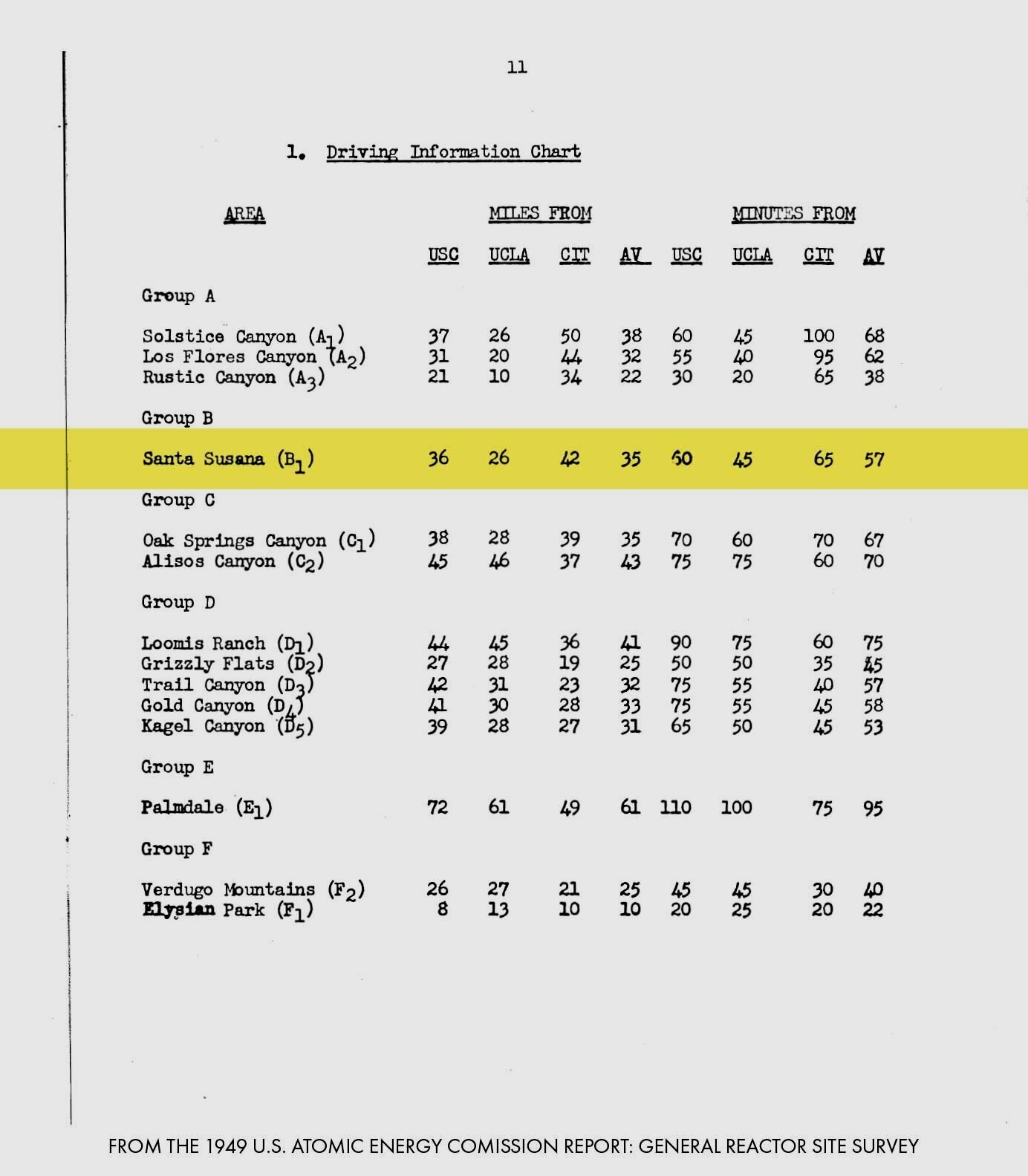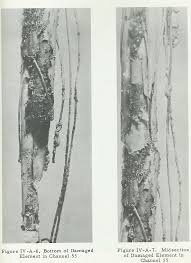
DISASTERS
SSFL > HISTORY > ACCIDENTS
Location Fail
In the 1940s the Atomic Energy Commission needed a site for their lab that wasn’t close to the city, a “field” lab. They knew their dangerous experiments needed to be done in an area where people wouldn’t get hurt if there was any kind of nuclear accident. They conducted a General Reactor Site Survey to pick the safest spot.
Even though the SSFL was 5th out of 6th for meteorological characteristics (the winds could blow contamination toward populated areas) it was chosen because it was closest to the universities and the scientists didn’t want to drive as far to a safer location.
sre
Sodium Reactor Experiment (SRE), building 4143
Atomics International, a division of North American Aviation, used Area IV for the Sodium Reactor Experiment (SRE). The SRE operated at the site from 1957 to 1964, the reactor was removed in 1981 and the building torn down in 1999.
On July 12, 1959 thirteen of forty-three fuel rods in the SRE reactor core failed due to overheating. You can read the details about the SRE meltdown in Dr. Lochbaum’s Report.
According to eyewitness John Pace, in order to prevent an explosion the workers were told to vent the radioactive gasses into the open air. According to an analysis of a five-year study by a panel of independent scientists, the SRE accident spit out up to 459 times the amount of radiation released during the 1979 meltdown at Three Mile Island.
Eyewitness and former employee John Pace has shared publicly that he was told to vent the radioactive gases from the SRE out open doors to prevent an explosion. Pace’s story is featured in the Emmy-nominated documentary “In the Dark of the Valley.”
Exterior view of the SRE building 4143 (to the right)
Interior view of the SRE building 4143.
Documentation of the melted fuel rods from the SRE meltdown.
Video by Department of Energy after the Santa Susana Field Lab’s SRE meltdown.
Other nuclear accidents
Nuclear Facilities at SSFL
Plutonium Fuel Fabrication Facility, Building 0551
Uranium Carbide Fuel Fabrication Facility, Building 005
Van de Graaf Particle Accelerators, Building 4009
Seven “Critical Facilities,” i.e. facilities housing operations involving masses of fissionable material capable of sustaining a nuclear chain reaction.
Radioactive Materials Handling / Disposal Facility (RMDF / RMHF)’s low-level radioactive waste incinerator
Hot Lab Building 202: Accepted spent nuclear fuel from other Atomic Energy Commission (AEC) and Department of Energy (DOE) facilities from around the country to be declared and examined for reuse.
Documented Nuclear Accidents
1959: The AE6 reactor experienced a release of fission gases. (L-85/AE-6 REACTOR, BUILDING 0931)
1964: The SNAP8ER experienced damage to 80% of its fuel. (BUILDING 057 )
1969: SNAP8 Development Reactor experienced damage to a third of its fuel (BUILDING 057)
The hot lab suffered a number of fires. For example, in 1957, a fire "got out of control and ... massive contamination" resulted.
Radioactive isotopes historically used at SSFL
Contaminants and isotopes include uranium, thorium, transuranic elements, mixed fission products, and activation products such as U-238, U-234, U-235, U-236, Pu-238, Pu-239, Pu-240, Pu-241, Pu-242, Am-241, Am-243, Th-228, Th-231, Th-232, Th-234, H-3 (tritium), C-14, Na-22, Na-24, Cr-51, Mn-54, Ni-59, Ni-63, Fe-59, Co-57, Co-60, Kr-85, Sr-89, Sr-90, Sb-125, I-129, I-131, Cs-134, Cs-137, Ce-144, Ba-La-140, Nb-95, Ru-103, Ru-106, Xn-133 (Xe-133), Xe-135, Pm-147, Sm-151, Eu-152, Eu-154, Ra-226, Ac-228, Pa-234m, Pb-214, Pb-212, Bi-214, Bi-212, Tl-208, S-35, P-32, and Be-10.
chemical leaks
Over 30,000 rocket engine tests were conducted at the SSFL from 1949 to 2006. Due to inadequate and faulty catch ponds, it’s estimated that 500,000 gallons of Trichloroethylene (TCE), a highly toxic solvent, was lost into the soil and groundwater. (1) Other volatile organic compounds have been detected in the SSFL groundwater such as trans-1,2-dichloroethylene, vinyl chloride, Freon-113, toluene, benzene, (2) and perchlorate. (3)





















explosions
On December 11, 2002, a Department of Energy (DOE) official, Mike Lopez, described typical clean-up procedures executed by Field Lab employees in the past. Workers would dispose of barrels filled with highly toxic waste by shooting the barrels with rifles so that they would explode and release their contents into the air. It is unclear when this process ended, but for certain did end prior to the 1990s.
On July 26, 1994, two SSFL scientists, Otto K. Heiney, of Canoga Park, and physicist Larry Pugh, of Thousand Oaks, were killed when the chemicals they were illegally burning in open pits exploded. Lee Wells, an eyewitness to the explosion, suffered second and third degree burns. After a grand jury investigation and FBI raid on the facility, three Rocketdyne officials pleaded guilty in June 2004 to illegally storing explosive materials. The jury deadlocked on the more serious charges related to illegal burning of hazardous waste.
Los Angeles Times, 1996: Rockwell Faces U.S. Charges in Lab Deaths
Los Angeles Times, 2001: Illegal Burn Ordered, Chemist Testifies
Los Angeles Times, 2003: Scientist Fined $100 in Lab Blast That Killed 2
Los Angeles Times, 2003: Executive Sentenced in '94 Blast
Los Angeles Times, 2002: Ex-Rocketdyne Worker Describes Fatal 1994 Blast
1
2
3
2007 Preliminary Assessment/Site Inspection Report SSFL California:
Extensive use of the most predominant hazardous substance at the site, trichloroethylene (TCE), has impacted the groundwater beneath the site. Several TCE plumes exist throughout the site. (PDF page 7)
It is estimated that up to 800,000 gallons of TCE were used to clean and flush out rocket engines after testing. Spent TCE was discharged from the test stands to a series of drainage channels and surface impoundments. Many of the drainage channels and impoundments were either unlined or lined with poorly maintained concrete. As a result, the groundwater beneath the site was contaminated with TCE. High concentrations of TCE remain in the groundwater. (PDF page 17)
TCE is not a naturally occurring substance and should not be present at background concentrations… The groundwater beneath the SSFL site continues to remain contaminated with TCE, with current data indicating concentrations as high as 110,000 ppb (State and Federal drinking water limits of 5 ppb). This release is attributable to the SSFL site because TCE has been used extensively throughout its operational history. (PDF page 14)
Preliminary Assessment/Site Inspection Report Santa Susana Field Laboratory Simi Valley, California: Although other volatile organic compounds, such as trans-1,2-dichloroethylene, vinyl chloride, Freon-113, toluene, and benzene, also have been detected, TCE is the compound detected with the highest concentration and greatest frequency. (PDF page 12)
Santa Susana Field Laboratory Groundwater Investigation: Perchlorate was detected in 56 of 277 wells at the SSFL. The highest concentration was measured at 1,600 parts per billion. (PDF page 8)
references & Documents:
Rocketdyne, it's the pits Ventura County Reporter, 2002
Geologic Features and their Potential Effects on Contaminant Migration, Santa Susana Field Laboratory
Dr. Howard WilshireMigration of SSFL Perchlorate Contamination Offsite
Dr. Ali TabidianLoss of Innocence
Dawn Kowalksi, Holly Huff, Marie Mason and Barbara Johnson









